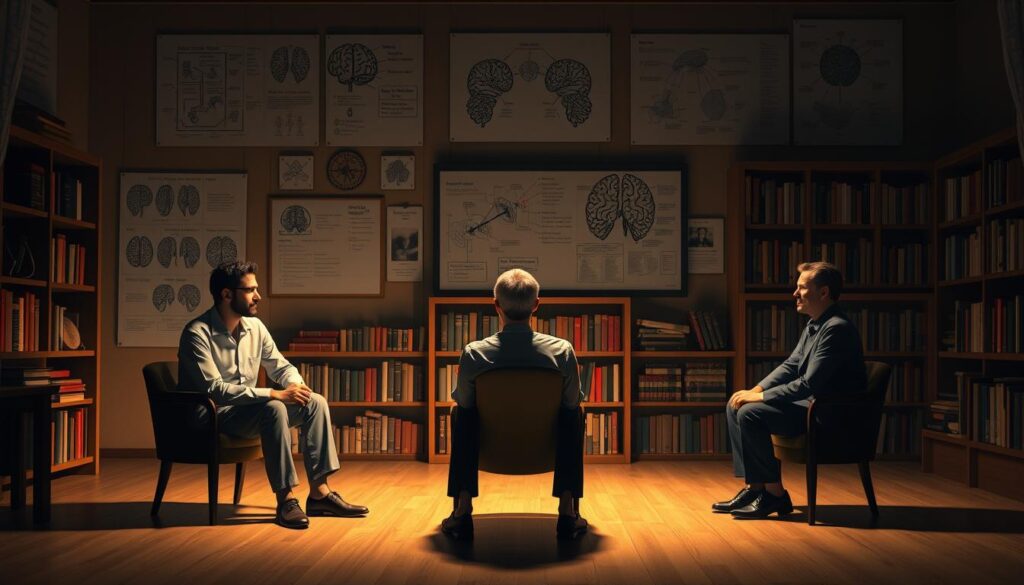Discover the Power of Cognitive Behavioral Therapy

Understanding Cognitive Behavioral Therapy (CBT)
Cognitive Behavioral Therapy (CBT) is a powerful approach to mental health. It focuses on changing negative thought patterns and behaviors. This helps individuals manage their mental health better.
What is CBT?
CBT is a type of psychotherapy that helps people understand and change their thoughts, feelings, and actions. It’s based on the idea that our thoughts, feelings, and actions are connected. By changing one, we can improve the others.
How Does CBT Work?
CBT works by identifying and challenging negative thought patterns. It helps individuals learn new ways to think and behave. This leads to better mental health and well-being.
Benefits of CBT
CBT offers many benefits. It can help with anxiety, depression, and other mental health issues. It also improves relationships and overall well-being. CBT is a helpful tool for managing mental health.
What is Cognitive Behavioral Therapy?
Cognitive Behavioral Therapy (CBT) is a way to help people change their thoughts and actions. It aims to improve how we handle our emotions and deal with tough situations.
Definition and Overview
CBT is a form of therapy that looks at how our thoughts and actions affect our feelings. It’s based on the idea that problems come from learning bad habits. CBT helps people see their negative thoughts differently and find better ways to cope.
Key Principles of CBT
- Cognitive restructuring: Identifying and challenging negative thought patterns and replacing them with more balanced and constructive ones.
- Behavioral activation: Encouraging individuals to engage in activities they have been avoiding due to their psychological distress, thereby helping them regain a sense of mastery and pleasure.
- Problem-solving: Assisting individuals in developing effective coping strategies and skills to manage their problems.
Origins and Development of CBT
CBT started in the 1960s as a new way to think about therapy. It mixed ideas from behavior and cognitive psychology. Today, CBT has grown to include parts from mindfulness and acceptance therapy.
How Does Cognitive Behavioral Therapy Work?
Cognitive Behavioral Therapy (CBT) helps people with mental health issues. It’s a team effort between the therapist and the client. They work together to change negative thoughts and behaviors.
The CBT Process Explained
CBT is a structured therapy with clear goals. It focuses on understanding thoughts, feelings, and actions. The therapist teaches the client new ways to cope and manage their mental health.
Role of the Therapist in CBT
The therapist is key in CBT. They guide the client, offer support, and teach skills for mental health management. A strong therapeutic relationship is crucial for success in CBT.
Benefits of Cognitive Behavioral Therapy
Cognitive Behavioral Therapy (CBT) is a valuable approach to managing various mental health issues. It offers numerous benefits that can enhance overall well-being.
Improvement in Emotional Well-being
CBT is known to improve emotional well-being. It teaches individuals skills to manage their emotions more effectively. Through CBT, individuals can develop a better understanding of their thought patterns and behaviors.
This leads to enhanced emotional regulation.
Practical Skills for Everyday Life
One of the significant advantages of CBT is that it equips individuals with practical skills. These skills can be applied in everyday life. They include problem-solving, coping with difficult emotions, and managing stress.
Evidence-Based Effectiveness
CBT is backed by a substantial body of research. It demonstrates its effectiveness in treating a wide range of mental health conditions. These include depression, anxiety disorders, and post-traumatic stress disorder (PTSD).
Common Issues Treated with CBT
## Common Issues Treated with Cognitive Behavioral Therapy
Cognitive Behavioral Therapy (CBT) is a helpful treatment for many mental health problems. We will look at the different conditions CBT can address.
### Anxiety Disorders
CBT is great for anxiety disorders like generalized anxiety, panic, social anxiety, and phobias. It helps by changing negative thoughts. People learn to handle their anxiety better.
Techniques like cognitive restructuring, exposure, and relaxation training are used. They help individuals deal with their anxiety.
### Depression
CBT is also good for depression. It helps people change negative thoughts that make them feel down. By learning to see things differently, they can feel more hopeful.
Techniques like behavioral activation and cognitive restructuring are used. They help people enjoy activities again.
### PTSD and Trauma-Related Issues
For those with PTSD and trauma, CBT offers a safe space. Techniques like exposure therapy and cognitive restructuring help. They help people face and change their traumatic memories.
This way, individuals can heal and find better ways to cope.
Understanding how CBT helps with these issues can improve emotional well-being. It helps people develop better coping strategies.
Cognitive Behavioral Therapy Techniques
Cognitive Behavioral Therapy (CBT) helps people understand and manage mental health issues. We will look at key CBT techniques. These can help change unhelpful thoughts and behaviors.
Identifying Negative Patterns
The first step in CBT is to spot your negative thought patterns. You need to understand the distorted thinking that causes your distress. Recognizing these patterns lets you tackle the root issues.
Cognitive Restructuring
Cognitive restructuring is a key CBT technique. It helps people challenge and replace negative thoughts with positive ones. This way, they can develop better coping strategies and improve their mental health.
Behavioral Activation
Behavioral activation is another important CBT technique. It encourages people to do activities they’ve been avoiding because of their mental health. By doing more, they can find joy and motivation for change.
Learning these CBT techniques can help you cope better with life’s challenges. They help you spot and change negative patterns, reframe your thinking, and adopt healthier behaviors.

The Role of Homework in CBT
Cognitive Behavioral Therapy (CBT) focuses on solving problems. It uses homework to help reinforce skills and knowledge. This is done during therapy sessions.
Importance of Assignments
Homework in CBT has many benefits. It helps reinforce what you’ve learned and practice new skills. It also helps you apply what you’ve learned in different situations.
Types of Homework Exercises
There are several types of homework exercises in CBT. These include self-monitoring, cognitive restructuring, behavioral activation, and problem-solving.
- Self-monitoring assignments track your thoughts, feelings, and actions.
- Cognitive restructuring exercises help you challenge negative thoughts.
- Behavioral activation tasks encourage you to do things you’ve been avoiding.
- Problem-solving exercises help you practice solving problems.
tag. The content should compare CBT with other therapeutic approaches.
## Step 2: Review the given information
The provided information includes the structure of the article, details about section 8, and guidelines for writing the content.
## Step 3: Plan the content for section 8
To write the content for section 8, we need to compare CBT with other therapeutic approaches, such as psychodynamic therapy and dialectical behavior therapy.
## Step 4: Write the content
### CBT vs. Other Therapeutic Approaches
Cognitive Behavioral Therapy (CBT) is a widely used approach. It focuses on changing negative thought patterns and behaviors. When comparing CBT with other approaches, several key differences emerge.
#### Comparison with Psychodynamic Therapy
Psychodynamic therapy, also known as psychoanalytic therapy, was developed by Sigmund Freud. It explores unconscious motivations and underlying causes of thoughts, feelings, and behaviors. Unlike CBT, which is more structured, psychodynamic therapy delves into the past.
#### Difference from Dialectical Behavior Therapy
Dialectical Behavior Therapy (DBT) shares similarities with CBT but has distinct differences. DBT is designed for individuals with borderline personality disorder. It focuses on developing mindfulness, distress tolerance, and emotional regulation skills. While both CBT and DBT are evidence-based, they differ in their theoretical underpinnings and techniques.
## Step 5: Structure the content
The content should be structured using appropriate HTML tags, including `
CBT vs. Other Therapeutic Approaches
`, and other relevant tags as necessary.
## Step 6: Finalize the content
The final content should be enclosed in a “ tag and written in American English.
The final answer is:
CBT vs. Other Therapeutic Approaches
Cognitive Behavioral Therapy (CBT) is a widely used approach. It focuses on changing negative thought patterns and behaviors. Several key differences emerge when comparing CBT with other approaches.
Comparison with Psychodynamic Therapy
Psychodynamic therapy, also known as psychoanalytic therapy, was developed by Sigmund Freud. It explores unconscious motivations and underlying causes of thoughts, feelings, and behaviors. Unlike CBT, which is more structured, psychodynamic therapy delves into the past.
Difference from Dialectical Behavior Therapy
Dialectical Behavior Therapy (DBT) shares similarities with CBT but has distinct differences. DBT is designed for individuals with borderline personality disorder. It focuses on developing mindfulness, distress tolerance, and emotional regulation skills. While both CBT and DBT are evidence-based, they differ in their theoretical underpinnings and techniques.

Who Can Benefit from Cognitive Behavioral Therapy?
Cognitive Behavioral Therapy (CBT) is a helpful approach for many people.
Children and Adolescents
CBT is great for kids and teens with anxiety, depression, or other mental health problems.
Adults and Aging Populations
CBT works well for adults and older people too. It helps with stress, anxiety, and depression. It also tackles aging-related issues.
Finding a Qualified CBT Therapist
Looking for a cognitive behavioral therapy (CBT) therapist? There are important things to consider. A good therapist can make a big difference in your therapy.
What to Look for in a Therapist
A great CBT therapist has certain qualities. They should have experience and training. They should also have a style that fits your needs and strong communication skills. Plus, they should have the right credentials.
Questions to Ask During Initial Consultations
When meeting a potential CBT therapist, ask these questions:
- What experience do you have with clients like me?
- How will you make your therapy fit my needs and goals?
- Can you tell me about your CBT training and credentials?
- How will you keep my sessions confidential and professional?
- How will you handle tough or sensitive topics in therapy?
Online Cognitive Behavioral Therapy Resources
Cognitive Behavioral Therapy (CBT) is now easier to find online. It offers many tools for those looking to improve their mental health.
Teletherapy Options
Teletherapy, or online therapy, is a great option. It’s easy and effective for getting CBT.
Apps and Platforms for Self-Help
Many apps and websites help with self-directed CBT. MoodTools, CBT Workbook, and Happify are some examples.
These online tools are great for adding to traditional therapy. They let people work on their mental health whenever they can.
Challenges in Cognitive Behavioral Therapy
## Challenges in Cognitive Behavioral Therapy
### Possible Limitations
Cognitive Behavioral Therapy (CBT) is a popular method for treating mental health issues. But, it’s not perfect for everyone. It might not work well for those with severe mental health problems or who need more intense therapy.
### Overcoming Resistance to Change
One big challenge in CBT is helping people change their ways of thinking. Many find it hard to face their negative thoughts. To overcome this, it’s key to use techniques like cognitive restructuring.
CBT strategies, like cognitive restructuring, can really help. They help people change their negative thoughts into more positive ones. This way, they can handle stress better and feel emotionally better.
Other CBT techniques, like behavioral activation, are also useful. This method encourages people to do things they’ve been avoiding. It helps them break the cycle of avoidance and find better ways to cope.
Understanding the challenges of CBT helps people make better choices about their therapy. It’s important to work with a skilled therapist who can adjust CBT to fit your needs.
In summary, while CBT is very effective, it has its own set of challenges. By facing these challenges, people can get the most out of CBT and see better results.
## Your First Cognitive Behavioral Therapy Session
Getting ready for your first cognitive behavioral therapy (CBT) session? It’s key to know what’s coming and how to get the most out of it. CBT helps by changing negative thoughts and behaviors. Being ready sets a good start for your therapy.
What to Expect
In your first CBT session, you’ll talk about your worries, feelings, and experiences with a trained therapist. They’ll help you find areas to improve and create a plan just for you. You’ll learn CBT methods like cognitive restructuring and behavioral activation to better manage your symptoms.
Preparations Before the Session
Before your first CBT session, collect info about your mental health concerns. This will help you get the most from your therapy. Think about what you want to work on and be ready to share it with your therapist. This way, you’ll be ready for a helpful and productive therapy session.
Knowing what to expect and being prepared makes your CBT more effective. It helps you make real progress in managing your mental health.
## FAQ
### Q: What is Cognitive Behavioral Therapy (CBT)?
Cognitive Behavioral Therapy (CBT) is a form of therapy. It focuses on changing negative thoughts and behaviors. These changes help with mental health issues.
### Q: How does CBT work?
CBT helps people understand and tackle mental health problems. This is done through a team effort between the therapist and client.
### Q: What are the benefits of Cognitive Behavioral Therapy?
CBT improves emotional health and teaches useful life skills. It’s also proven to help with depression and other mental health issues.
### Q: What issues can CBT treat?
CBT can help with anxiety, depression, PTSD, and trauma. It teaches people to change harmful thoughts and behaviors.
### Q: What are some common CBT techniques?
CBT uses techniques like identifying negative patterns and changing thoughts. It also includes behavioral activation. These help people cope better with life.
### Q: How can I find a qualified CBT therapist?
To find a good CBT therapist, look for trained professionals. Ask questions during your first meeting to make sure you’re getting the right care.
### Q: Can CBT be done online?
Yes, CBT is available online. You can use teletherapy or apps. This makes it easier and more flexible.
### Q: What should I expect in my first CBT session?
In your first session, you’ll talk about your goals and challenges. You’ll start working on strategies to improve your mental health.
### Q: Is CBT suitable for everyone?
CBT works for people of all ages. It’s effective for children, teens, adults, and seniors. It’s a versatile therapy.
### Q: What are the limitations of CBT?
CBT isn’t for everyone. Some people might find it hard to change. But, the therapy can help with these challenges.
### Q: How can I prepare for my CBT sessions?
To get ready for CBT, learn about the process. Know your goals and challenges. Be open to the therapy.




